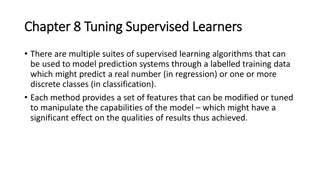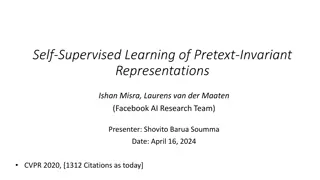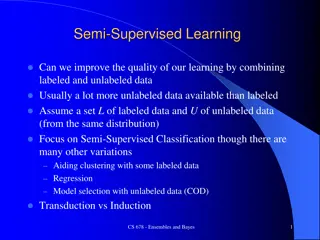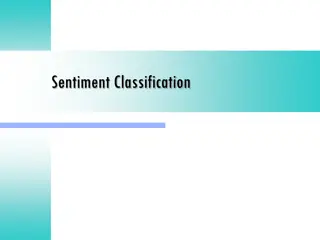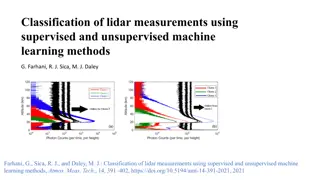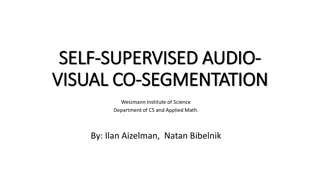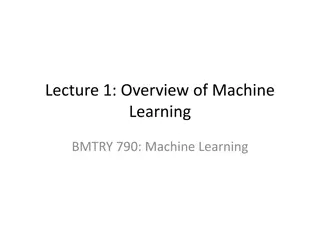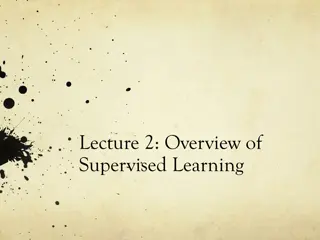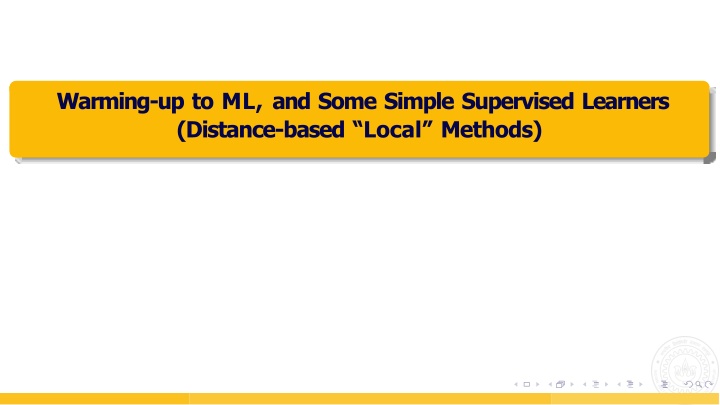
Supervised Learning in Machine Learning
Dive into the basics of supervised learning in machine learning, exploring input-output pairs, notation conventions, and the representation of data through feature vectors and pixel intensities. Learn how good features can be extracted from data for training.
Download Presentation

Please find below an Image/Link to download the presentation.
The content on the website is provided AS IS for your information and personal use only. It may not be sold, licensed, or shared on other websites without obtaining consent from the author. If you encounter any issues during the download, it is possible that the publisher has removed the file from their server.
You are allowed to download the files provided on this website for personal or commercial use, subject to the condition that they are used lawfully. All files are the property of their respective owners.
The content on the website is provided AS IS for your information and personal use only. It may not be sold, licensed, or shared on other websites without obtaining consent from the author.
E N D
Presentation Transcript
Warming-up to ML, and Some Simple Supervised Learners (Distance-based Local Methods) Warming-up to ML, and Some Simple Supervised Learners
Some Notation/Nomenclature/Convention (x ,y )}N Supervised Learning requires training data given as a set of input-output pairs { n n n=1 Unsupervised Learning requires training data given as a set of inputs {x }N n n=1 Warming-up to ML, and Some Simple Supervised Learners 3
Some Notation/Nomenclature/Convention (x ,y )}N Supervised Learning requires training data given as a set of input-output pairs { n n n=1 Unsupervised Learning requires training data given as a set of inputs {x }N n n=1 Each input xnis (usually) a vector containing the values of the features or attributes or covariates that encode properties of the data it represents, e.g., Warming-up to ML, and Some Simple Supervised Learners 3
Some Notation/Nomenclature/Convention (x ,y )}N Supervised Learning requires training data given as a set of input-output pairs { n n n=1 Unsupervised Learning requires training data given as a set of inputs {x }N n n=1 Each input xnis (usually) a vector containing the values of the features or attributes or covariates that encode properties of the data it represents, e.g., Representing a 7 7 image: xncan be a 49 1 vector of pixel intensities Warming-up to ML, and Some Simple Supervised Learners 3
Some Notation/Nomenclature/Convention (x ,y )}N Supervised Learning requires training data given as a set of input-output pairs { n n n=1 Unsupervised Learning requires training data given as a set of inputs {x }N n n=1 Each input xnis (usually) a vector containing the values of the features or attributes or covariates that encode properties of the data it represents, e.g., Representing a 7 7 image: xncan be a 49 1 vector of pixel intensities Note: Good features can also be learned from data (feature learning) or extracted using hand-crafted rules defined by a domain expert. Warming-up to ML, and Some Simple Supervised Learners 3
Some Notation/Nomenclature/Convention (x ,y )}N Supervised Learning requires training data given as a set of input-output pairs { n n n=1 Unsupervised Learning requires training data given as a set of inputs {x }N n n=1 Each input xnis (usually) a vector containing the values of the features or attributes or covariates that encode properties of the data it represents, e.g., Representing a 7 7 image: xncan be a 49 1 vector of pixel intensities Note: Good features can also be learned from data (feature learning) or extracted using hand-crafted rules defined by a domain expert. Having a good set of features is half the battle won! Warming-up to ML, and Some Simple Supervised Learners 3
Some Notation/Nomenclature/Convention (x ,y )}N Supervised Learning requires training data given as a set of input-output pairs { n n n=1 Unsupervised Learning requires training data given as a set of inputs {x }N n n=1 Each input xnis (usually) a vector containing the values of the features or attributes or covariates that encode properties of the data it represents, e.g., Representing a 7 7 image: xncan be a 49 1 vector of pixel intensities Note: Good features can also be learned from data (feature learning) or extracted using hand-crafted rules defined by a domain expert. Having a good set of features is half the battle won! Each ynis the output or response or label associated with input xn Warming-up to ML, and Some Simple Supervised Learners 3
Some Notation/Nomenclature/Convention (x ,y )}N Supervised Learning requires training data given as a set of input-output pairs { n n n=1 Unsupervised Learning requires training data given as a set of inputs {x }N n n=1 Each input xnis (usually) a vector containing the values of the features or attributes or covariates that encode properties of the data it represents, e.g., Representing a 7 7 image: xncan be a 49 1 vector of pixel intensities Note: Good features can also be learned from data (feature learning) or extracted using hand-crafted rules defined by a domain expert. Having a good set of features is half the battle won! Each ynis the output or response or label associated with input xn The output yncan be a scalar, a vector of numbers, or a structured object Warming-up to ML, and Some Simple Supervised Learners 3
Some Notation/Nomenclature/Convention Will assume each input xnto be a D 1 column vector (its transpose xTnwill be row vector) xnd will denote the d-th feature of the n-th input We will use X (N D feature matrix) to collectively denote all the N inputs We will use y (N 1 output/response/label vector) to collectively denote all the N outputs A feature D Input n Output for input n yn x xT xnD xn2 n1 n y X N Outputs Feature Matrix Warming-up to ML, and Some Simple Supervised Learners 4
Some Notation/Nomenclature/Convention Will assume each input xnto be a D 1 column vector (its transpose xTnwill be row vector) xnd will denote the d-th feature of the n-th input We will use X (N D feature matrix) to collectively denote all the N inputs We will use y (N 1 output/response/label vector) to collectively denote all the N outputs A feature D Input n Output for input n yn x xT xnD xn2 n1 n y X N Outputs Feature Matrix Note: If each ynitself is a vector (we will see such cases later) then we will use a matrix Y to collectively denote all the N outputs (with row n containing yn) and also use boldfaced yn Warming-up to ML, and Some Simple Supervised Learners 4
Getting Features from Raw Data: A Simple Example Consider the feature representation for some text data consisting of the following sentences: John likes to watch movies Mary likes movies too John also likes football Our feature vocabulary consists of 8 unique words Warming-up to ML, and Some Simple Supervised Learners 5
Getting Features from Raw Data: A Simple Example Consider the feature representation for some text data consisting of the following sentences: John likes to watch movies Mary likes movies too John also likes football Our feature vocabulary consists of 8 unique words Here is the bag-of-words feature vector representation of these 3 sentences Warming-up to ML, and Some Simple Supervised Learners 5
Getting Features from Raw Data: A Simple Example Consider the feature representation for some text data consisting of the following sentences: John likes to watch movies Mary likes movies too John also likes football Our feature vocabulary consists of 8 unique words Here is the bag-of-words feature vector representation of these 3 sentences Here the features are binary (presence/absence of each word) Warming-up to ML, and Some Simple Supervised Learners 5
Getting Features from Raw Data: A Simple Example Consider the feature representation for some text data consisting of the following sentences: John likes to watch movies Mary likes movies too John also likes football Our feature vocabulary consists of 8 unique words Here is the bag-of-words feature vector representation of these 3 sentences Here the features are binary (presence/absence of each word) Again, note that this may not necessarily be the best feature representation for a given task (which is why other techniques or feature learning may be needed) Warming-up to ML, and Some Simple Supervised Learners 5
Types of Features and Types of Outputs Features (in vector xn) as well as outputs yncan be real-valued, binary, categorical, ordinal, etc. Warming-up to ML, and Some Simple Supervised Learners 6
Types of Features and Types of Outputs Features (in vector xn) as well as outputs yncan be real-valued, binary, categorical, ordinal, etc. Real-valued: Pixel intensity, house area, house price, rainfall amount, temperature, etc Warming-up to ML, and Some Simple Supervised Learners 6
Types of Features and Types of Outputs Features (in vector xn) as well as outputs yncan be real-valued, binary, categorical, ordinal, etc. Real-valued: Pixel intensity, house area, house price, rainfall amount, temperature, etc Binary: Male/female, adult/non-adult, or any yes/no or present/absent type values Warming-up to ML, and Some Simple Supervised Learners 6
Types of Features and Types of Outputs Features (in vector xn) as well as outputs yncan be real-valued, binary, categorical, ordinal, etc. Real-valued: Pixel intensity, house area, house price, rainfall amount, temperature, etc Binary: Male/female, adult/non-adult, or any yes/no or present/absent type values Categorical/Discrete: Pincode, bloodgroup, or any which one from this finite set type values Warming-up to ML, and Some Simple Supervised Learners 6
Types of Features and Types of Outputs Features (in vector xn) as well as outputs yncan be real-valued, binary, categorical, ordinal, etc. Real-valued: Pixel intensity, house area, house price, rainfall amount, temperature, etc Binary: Male/female, adult/non-adult, or any yes/no or present/absent type values Categorical/Discrete: Pincode, bloodgroup, or any which one from this finite set type values Ordinal: Grade (A/B/C etc.) in a course, or any other type where relative values matters Warming-up to ML, and Some Simple Supervised Learners 6
Types of Features and Types of Outputs Features (in vector xn) as well as outputs yncan be real-valued, binary, categorical, ordinal, etc. Real-valued: Pixel intensity, house area, house price, rainfall amount, temperature, etc Binary: Male/female, adult/non-adult, or any yes/no or present/absent type values Categorical/Discrete: Pincode, bloodgroup, or any which one from this finite set type values Ordinal: Grade (A/B/C etc.) in a course, or any other type where relative values matters Often, the features can be of mixed types (some real, some categorical, some ordinal, etc.) Warming-up to ML, and Some Simple Supervised Learners 6
Types of Features and Types of Outputs Features (in vector xn) as well as outputs yncan be real-valued, binary, categorical, ordinal, etc. Real-valued: Pixel intensity, house area, house price, rainfall amount, temperature, etc Binary: Male/female, adult/non-adult, or any yes/no or present/absent type values Categorical/Discrete: Pincode, bloodgroup, or any which one from this finite set type values Ordinal: Grade (A/B/C etc.) in a course, or any other type where relative values matters Often, the features can be of mixed types (some real, some categorical, some ordinal, etc.) Appropriate handling of different types of features may be very important (even if you algorithm is designed to learn good features, given a set of heterogeneous features) Warming-up to ML, and Some Simple Supervised Learners 6
Types of Features and Types of Outputs Features (in vector xn) as well as outputs yncan be real-valued, binary, categorical, ordinal, etc. Real-valued: Pixel intensity, house area, house price, rainfall amount, temperature, etc Binary: Male/female, adult/non-adult, or any yes/no or present/absent type values Categorical/Discrete: Pincode, bloodgroup, or any which one from this finite set type values Ordinal: Grade (A/B/C etc.) in a course, or any other type where relative values matters Often, the features can be of mixed types (some real, some categorical, some ordinal, etc.) Appropriate handling of different types of features may be very important (even if you algorithm is designed to learn good features, given a set of heterogeneous features) In Sup. Learning, different types of outputs may require different type of learning models Warming-up to ML, and Some Simple Supervised Learners 6
Supervised Learning Warming-up to ML, and Some Simple Supervised Learners
Supervised Learning Supervised Learning comes in many flavors. The flavor depends on the type of each output yn Warming-up to ML, and Some Simple Supervised Learners 8
Supervised Learning Supervised Learning comes in many flavors. The flavor depends on the type of each output yn Regression: yn R (real-valued scalar) Warming-up to ML, and Some Simple Supervised Learners 8
Supervised Learning Supervised Learning comes in many flavors. The flavor depends on the type of each output yn Regression: yn R (real-valued scalar) Multi-Output Regression: yn RM(real-valued vector containing M outputs) Warming-up to ML, and Some Simple Supervised Learners 8
Supervised Learning Supervised Learning comes in many flavors. The flavor depends on the type of each output yn Regression: yn R (real-valued scalar) Multi-Output Regression: yn RM(real-valued vector containing M outputs) 0.3 0.1 0.2 0.8 0.4 Illustration of a 5-dim output vector for a multi-output regression problem Warming-up to ML, and Some Simple Supervised Learners 8
Supervised Learning Supervised Learning comes in many flavors. The flavor depends on the type of each output yn Regression: yn R (real-valued scalar) Multi-Output Regression: yn RM(real-valued vector containing M outputs) 0.3 0.1 0.2 0.8 0.4 Illustration of a 5-dim output vector for a multi-output regression problem Binary Classification: yn { 1, +1} or {0,1} (output in classification is also called label ) Warming-up to ML, and Some Simple Supervised Learners 8
Supervised Learning Supervised Learning comes in many flavors. The flavor depends on the type of each output yn Regression: yn R (real-valued scalar) Multi-Output Regression: yn RM(real-valued vector containing M outputs) 0.3 0.1 0.2 0.8 0.4 Illustration of a 5-dim output vector for a multi-output regression problem Binary Classification: yn { 1, +1} or {0,1} (output in classification is also called label ) Multi-class Classification: yn {1, 2,...,M} or {0,1,...,M 1} (one of M classes is correct label) 0 0 1 0 0 Illustration of a 5-dim one-hot label vector for a multi-class classification problem Warming-up to ML, and Some Simple Supervised Learners 8
Supervised Learning Supervised Learning comes in many flavors. The flavor depends on the type of each output yn Regression: yn R (real-valued scalar) Multi-Output Regression: yn RM(real-valued vector containing M outputs) 0.3 0.1 0.2 0.8 0.4 Illustration of a 5-dim output vector for a multi-output regression problem Binary Classification: yn { 1, +1} or {0,1} (output in classification is also called label ) Multi-class Classification: yn {1, 2,...,M} or {0,1,...,M 1} (one of M classes is correct label) 0 0 1 0 0 Illustration of a 5-dim one-hot label vector for a multi-class classification problem Multi-label Classification: yn { 1, +1}Mor {0,1}M(a subset of M labels are correct) 0 1 0 0 1 Illustration of a 5-dim binary label vector for a multi-label classification problem (unlike one-hot, there can be multiple 1s) Warming-up to ML, and Some Simple Supervised Learners 8
Supervised Learning Supervised Learning comes in many flavors. The flavor depends on the type of each output yn Regression: yn R (real-valued scalar) Multi-Output Regression: yn RM(real-valued vector containing M outputs) 0.3 0.1 0.2 0.8 0.4 Illustration of a 5-dim output vector for a multi-output regression problem Binary Classification: yn { 1, +1} or {0,1} (output in classification is also called label ) Multi-class Classification: yn {1, 2,...,M} or {0,1,...,M 1} (one of M classes is correct label) 0 0 1 0 0 Illustration of a 5-dim one-hot label vector for a multi-class classification problem Multi-label Classification: yn { 1, +1}Mor {0,1}M(a subset of M labels are correct) 0 1 0 0 1 Illustration of a 5-dim binary label vector for a multi-label classification problem (unlike one-hot, there can be multiple 1s) Note: Multi-label classification is also informally called tagging (especially in Computer Vision) Warming-up to ML, and Some Simple Supervised Learners 8
Supervised Learning (Contd.) Structured-Prediction (a.k.a. Structured Output Learning): Each ynis a structured object Warming-up to ML, and Some Simple Supervised Learners 9
Supervised Learning (Contd.) Structured-Prediction (a.k.a. Structured Output Learning): Each ynis a structured object One-Class Classification (a.k.a. outlier/anomaly/novelty detection): ynis 1 or everything else Examples from the class being modeled (e.g., animals) All other examples ( outliers , e.g., humans, vehicles, etc) Warming-up to ML, and Some Simple Supervised Learners 9
Supervised Learning (Contd.) Structured-Prediction (a.k.a. Structured Output Learning): Each ynis a structured object One-Class Classification (a.k.a. outlier/anomaly/novelty detection): ynis 1 or everything else Examples from the class being modeled (e.g., animals) All other examples ( outliers , e.g., humans, vehicles, etc) Ranking: Each ynis a ranked list of relevant stuff for a given input/query x Warming-up to ML, and Some Simple Supervised Learners 9
Computing Distances/Similarities Assuming all real-valued features, an input xn RD 1is a point in a D dim. vector space of reals Warming-up to ML, and Some Simple Supervised Learners 10
Our First (Supervised) Learning Algorithm Warming-up to ML, and Some Simple Supervised Learners 11
Our First (Supervised) LearningAlgorithm (need to know nothing except how to compute distances/similarities between points!) Warming-up to ML, and Some Simple Supervised Learners 11
Prototype based Classification Given: N labeled training examples {x ,y } from two classes N n=1 n n Assume green is positive and red is negative class N+ exampes from positive class, N examples from negative class Our goal: Learn a model to predict label (class) y for a new test example x Warming-up to ML, and Some Simple Supervised Learners 12
Prototype based Classification Given: N labeled training examples {x ,y } from two classes N n=1 n n Assume green is positive and red is negative class N+ exampes from positive class, N examples from negative class Our goal: Learn a model to predict label (class) y for a new test example x A simple distance from means model: predict the class that has a closer mean Warming-up to ML, and Some Simple Supervised Learners 12
Prototype based Classification Given: N labeled training examples {x ,y } from two classes N n=1 n n Assume green is positive and red is negative class N+ exampes from positive class, N examples from negative class Our goal: Learn a model to predict label (class) y for a new test example x A simple distance from means model: predict the class that has a closer mean Note: The basic idea easily generalizes to more than 2 classes as well Warming-up to ML, and Some Simple Supervised Learners
Prototype based Classification: More Formally What does the decision rule look like, mathematically ? Warming-up to ML, and Some Simple Supervised Learners 13
Prototype based Classification: More Formally What does the decision rule look like, mathematically ? The mean of each class is given by 1 1 N N+ yn=+1 = and = xn x n + yn= 1 Warming-up to ML, and Some Simple Supervised Learners 13
Prototype based Classification: More Formally What does the decision rule look like, mathematically ? The mean of each class is given by 1 1 N N+ = = and xn xn + yn= 1 yn=+1 Euclidean Distances from each mean are given by || x||2 || + x||2 2 2 = || || + ||x|| 2 ,x 2 = || || + || x|| 2 ,x 2 + + Warming-up to ML, and Some Simple Supervised Learners 13
Prototype based Classification: More Formally What does the decision rule look like, mathematically ? The mean of each class is given by 1 1 = = and xn xn + N N+ yn= 1 yn=+1 Euclidean Distances from each mean are given by || x||2 || + x|| 2 2 = || || + ||x|| 2 ,x 2 = || || + || + x|| 2 ,x 2 2 + Decision Rule: If f (x) := || x||2 || + x||2> 0 then predict +1, otherwise predict -1 Warming-up to ML, and Some Simple Supervised Learners 13
Prototype based Classification: The Decision Rule We saw that our decision rule was f (x) := || x||2 || + x||2 Warming-up to ML, and Some Simple Supervised Learners 14
Prototype based Classification: The Decision Rule We saw that our decision rule was f (x) := || x||2 || + x||2= 2 + , x + || ||2 || +||2 Warming-up to ML, and Some Simple Supervised Learners 14
Prototype based Classification: The Decision Rule We saw that our decision rule was f (x) := || x||2 || + x||2= 2 + , x + || ||2 || +||2 Imp.:f (x ) effectively denotes a hyperplane based classification rule f (x ) = w Tx + b with the vector w = + representing the direction normal to the hyperplane Warming-up to ML, and Some Simple Supervised Learners 14
Prototype based Classification: The Decision Rule We saw that our decision rule was f (x) := || x||2 || + x||2= 2 + , x + || ||2 || +||2 Imp.:f (x ) effectively denotes a hyperplane based classification rule f (x ) = w Tx + b with the vector w = + representing the direction normal to the hyperplane N n=1 n xn,x + b, where s and b can be Imp.: Can show that the rule is equivalent to f (x) = estimated from training data (try this as an exercise) Warming-up to ML, and Some Simple Supervised Learners 14
Prototype based Classification: The Decision Rule We saw that our decision rule was f (x) := || x||2 || + x||2= 2 + , x + || ||2 || +||2 Imp.:f (x ) effectively denotes a hyperplane based classification rule f (x ) = w Tx + b with the vector w = + representing the direction normal to the hyperplane N n=1 n xn,x + b, where s and b can be Imp.: Can show that the rule is equivalent to f (x) = estimated from training data (try this as an exercise) This form of the decision rule is very important. Decision rules for many (in fact most) supervised learning algorithms can be written like this (weighted sum of similarities with all the training inputs) Warming-up to ML, and Some Simple Supervised Learners 14
Be Careful when Computing Distances 1Distance Metric Learning. See A Survey on Metric Learning for Feature Vectors and Structured Data by Ballet et al Warming-up to ML, and Some Simple Supervised Learners 15


